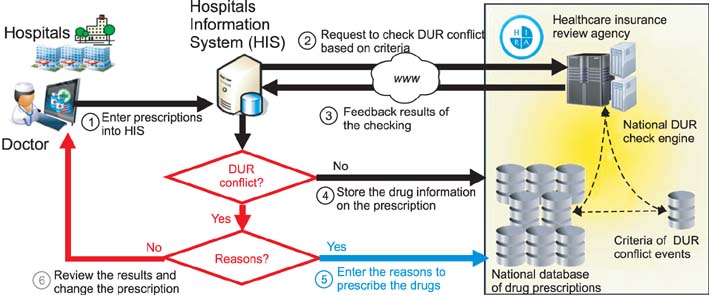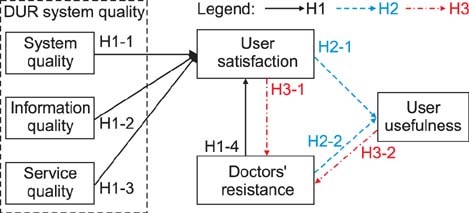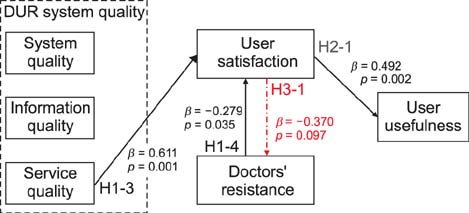Healthc Inform Res.
2014 Apr;20(2):99-108. 10.4258/hir.2014.20.2.99.
Impact of Doctors' Resistance on Success of Drug Utilization Review System
- Affiliations
-
- 1Department of Information Strategy, Samsung Medical Center, Seoul, Korea.
- 2Department of Industrial and Information Systems Engineering, Soongsil University, Seoul, Korea.
- 3Department of Surgery, Sungkyunkwan University School of Medicine, Seoul, Korea.
- 4Department of Medicine, Sungkyunkwan University School of Medicine, Seoul, Korea. s.woo.park@samsung.com
- 5Department of Quality Innovation, Samsung Medical Center, Seoul, Korea.
- KMID: 2284569
- DOI: http://doi.org/10.4258/hir.2014.20.2.99
Abstract
OBJECTIVES
The drug utilization review (DUR) system, which checks any conflict event of medications, contributes to improve patient safety. One of the important barriers in its adoption is doctors' resistance. This study aimed to analyze the impacts of doctors' resistance on the success of the DUR system.
METHODS
This study adopted an augmented the DeLone and McLean Information System (D&M IS) Success Model (2003), which used doctors' resistance as a socio-technological measure. This study framework is the same as that of the D&M IS Success Model in that it is based on qualities, such as system, information, and services. The major difference is that this study excluded the variable 'use' because it was not statistically significant for mandatory systems. A survey of doctors who used computers to enter prescriptions was conducted at a Korean tertiary hospital in February 2012.
RESULTS
This study is very meaningful in that it is the first study to explore the success factors of the DUR system associated with doctors' resistance. Doctors' resistance to the DUR system was not statistically associated with user usefulness, whereas it affected user satisfaction.
CONCLUSIONS
The results indicate that doctors still complain of discomfort in using the DUR system in the outpatient clinical setting, even though they admit that it contributes to patient safety. To mitigate doctors' resistance and raise user satisfaction, more opinions from doctors regarding the DUR system have to be considered and have to be reflected in the system.
MeSH Terms
Figure
Reference
-
1. Staggers N, Thompson CB, Snyder-Halpern R. History and trends in clinical information systems in the United States. J Nurs Scholarsh. 2001; 33(1):75–81.
Article2. Ammenwerth E, Graber S, Herrmann G, Burkle T, Konig J. Evaluation of health information systems-problems and challenges. Int J Med Inform. 2003; 71(2-3):125–135.
Article3. Kohn LT, Corrigan JM, Donaldson MS. To err is human: building a safer health system. Washington (DC): National Academy Press;2000.4. Erwin WG. The definition of drug utilization review: statement of issues. Clin Pharmacol Ther. 1991; 50(5 Pt 2):596–599.
Article5. Sittig DF, Kuperman GJ, Fiskio J. Evaluating physician satisfaction regarding user interactions with an electronic medical record system. Proc AMIA Symp. 1999; 1999:400–404.6. Berger RG, Kichak JP. Computerized physician order entry: helpful or harmful? J Am Med Inform Assoc. 2004; 11(2):100–103.
Article7. Bates DW, Gawande AA. Improving safety with information technology. N Engl J Med. 2003; 348(25):2526–2534.
Article8. Lee F, Teich JM, Spurr CD, Bates DW. Implementation of physician order entry: user satisfaction and self-reported usage patterns. J Am Med Inform Assoc. 1996; 3(1):42–55.
Article9. Carroll C, Marsden P, Soden P, Naylor E, New J, Dornan T. Involving users in the design and usability evaluation of a clinical decision support system. Comput Methods Programs Biomed. 2002; 69(2):123–135.
Article10. Aarts J, Ash J, Berg M. Extending the understanding of computerized physician order entry: implications for professional collaboration, workflow and quality of care. Int J Med Inform. 2007; 76:Suppl 1. S4–S13.
Article11. Chae YM, Kwak EA. Management issues for hospital information systems in Korea. J Korean Soc Med Inform. 2005; 11(04):323–336.
Article12. Choi JS, Moon J, Kim D. Design and implementation of concurrent drug utilization review system in a general hospital. ICIC Express Lett. 2013; 7(5):1533–1538.13. Park JY. Status and evaluation of pilot study of drug utilization review. J Pharm Pol Res. 2010; 5(1):18–29.14. Jen WY, Chao CC. Measuring mobile patient safety information system success: an empirical study. Int J Med Inform. 2008; 77(10):689–697.
Article15. Golob JF Jr, Fadlalla AM, Kan JA, Patel NP, Yowler CJ, Claridge JA. Validation of Surgical Intensive Care-Infection Registry: a medical informatics system for intensive care unit research, quality of care improvement, and daily patient care. J Am Coll Surg. 2008; 207(2):164–173.
Article16. Petter S, Fruhling A. Evaluating the success of an emergency response medical information system. Int J Med Inform. 2011; 80(7):480–489.
Article17. Yu P. A multi-method approach to evaluate health information systems. Stud Health Technol Inform. 2010; 160(Pt 2):1231–1235.18. Booth RG. Examining the functionality of the DeLone and McLean information system success model as a framework for synthesis in nursing information and communication technology research. Comput Inform Nurs. 2012; 30(6):330–345.
Article19. DeLone WH, McLean ER. The DeLone and McLean model of information systems success: a ten-year update. J Manag Inf Syst. 2003; 19(4):9–30.
Article20. Sedera D, Gable G. A factor and structural equation analysis of the enterprise systems success measurement model. In : Proceedings of the 25th International Conference on Information Systems; 2004 Dec 12-15; Washington, DC.21. Seddon PB, Staples S, Patnayakuni R, Bowtell M. Dimensions of information systems success. Commun Assoc Inf Syst. 1999; 2:2–39.
Article22. Van Der Meijden MJ, Tange HJ, Troost J, Hasman A. Determinants of success of inpatient clinical information systems: a literature review. J Am Med Inform Assoc. 2003; 10(3):235–243.
Article23. Murff HJ, Kannry J. Physician satisfaction with two order entry systems. J Am Med Inform Assoc. 2001; 8(5):499–509.
Article24. Ventura ML, Battan AM, Zorloni C, Abbiati L, Colombo M, Farina S, et al. The electronic medical record: pros and cons. J Matern Fetal Neonatal Med. 2011; 24:Suppl 1. 163–166.
Article25. Yi GH. Social science research methods. Seoul, Korea: Bobmunsa;2008.
- Full Text Links
- Actions
-
Cited
- CITED
-
- Close
- Share
- Similar articles
-
- The Effects after Implementing a Drug Utilization Review System on Contraindicated Drug use: A Systematic Review
- Drug Utilization Review (DUR) Policy of Government and Directivity
- Strategy for establishing an effective Korean drug utilization review system
- Antibiotic Control Policies in South Korea, 2000-2013
- Current status of pharmaceutical safety management in Korea




